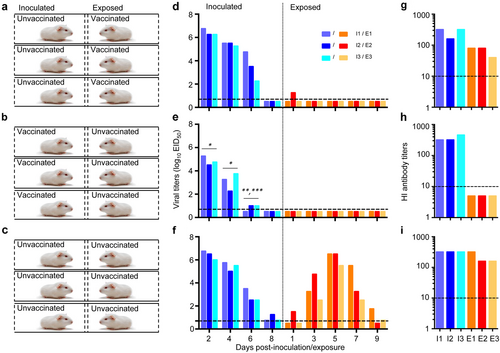Figures & data
Genetic and the antigenic relationships between the A/Anhui/1/2013(AH/1) virus and two H7N9 highly pathogenic influenza viruses
Groups of ten mice were inoculated with one or two doses, with a 3-week interval, of 106 EID50 of the H7N9/AAca virus vaccine. Three weeks after the last dose, sera were collected to determine HI (a) and NT (b) antibody titers by using the homologous H7N9/AAca virus and the heterologous CK/S1220 and CK/SD008-PB2/627 K viruses, respectively. The dotted lines indicate the lower limit of detection
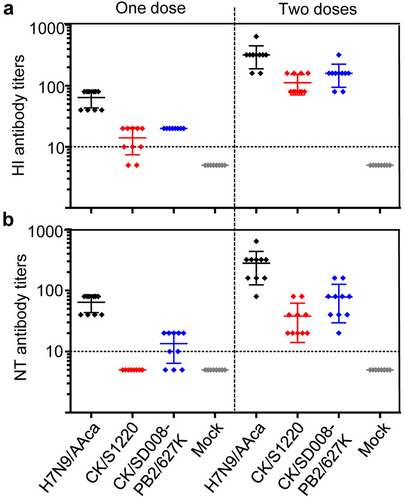
Groups of ten mice were vaccinated i.n. with 106 EID50 of H7N9/AAca once or twice (three weeks apart); three weeks later, mice were challenged with the indicated viruses. Nasal turbinates, lungs, spleens, kidneys, and brains were collected from three mice in each group on day 3 post-challenge for virus titration (a, b). Body weight (c, d) and survival (e, f) of the remaining seven mice were monitored for 2 weeks. Data shown are the mean virus titers of three mice (a, b) or mean body weights of seven mice (c, d); the error bar shows the standard deviation. *P < 0.05, **P < 0.01, ***P < 0.001 compared with the corresponding value for PBS (mock)-vaccinated mice
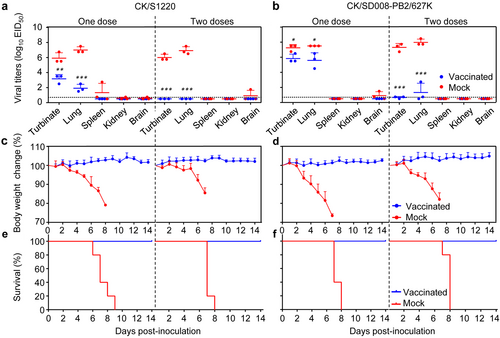
The amino acid differences between the two viruses are shown as single letters at the indicated positions. Each amino acid of CK/SD008-PB2/627 K is shown before the number of the position, and each amino acid of CK/S1220 is shown after the number of the position. The amino acids at positions 32, 122, 178, and 226 of HA are in H3 numbering. *the PB1-F1 protein of CK/SD008-PB2/627 K has 14 more amino acids (-SKRWKLFSKQEWTN-) in its amino-terminal compared with that of the CK/S1220 virus
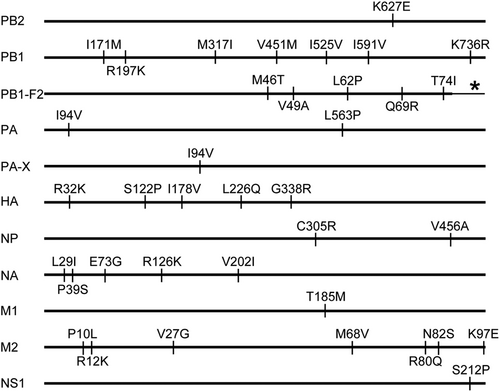
Viruses were compared for their ability to bind to sialyglycopolymers containing either α2,6-siaylglycopolymer or α2,3-siaylglycopolymer. The A/Sichuan/1/2009(H1N1) and A/chicken/Hebei/3/2013(H5N2)viruses were used as controls
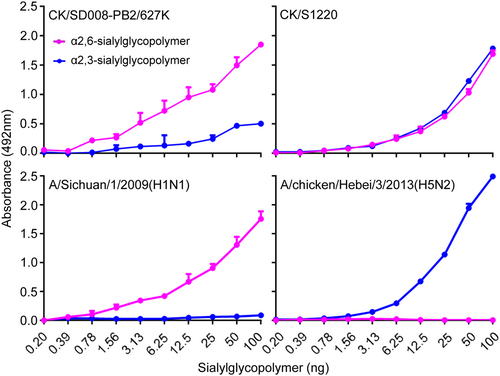
To test for viral replication,groups of three guinea pigs were inoculated i.n. with 106EID50 of the CK/S1220 (a) or CK/SD008-PB2/627 K (b) virus. The animals were killed on day 3 post-inoculation,and nasal washes and lungs were collected for virus titration. To test for transmission, groups of three guinea pigs were inoculated i.n. with 106EID50 of the CK/S1220 (c) or CK/SD008-PB2/627K (d) virus, and each guinea pig was placed into a separate cage; 24 h later, three naive guinea pigs were placed in the neighboring cages. Nasal washes were collected every two days from all animals beginning 2 days p.i. to test for virus shedding. Seroconversion of the CK/S1220- (e) or CK/SD008-PB2/627K- (f) inoculated or exposed animals was tested for on day 21 post-inoculation or post-exposure. Each color bar represents the virus titer or antibody titer from an individual animal. The dashed lines in these panels indicate the lower limit of detection
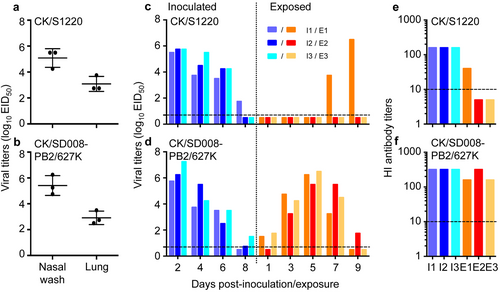
Two groups of three guinea pigs were inoculated with 106 EID50 of H7N9/AAca. Three weeks later, one group was put in the neighboring cages that hosted three guinea pigs that were inoculated with 106.EID50 of CK/SD008-PB2/627 K virus (a); another group was inoculated with 106 EID50 of CK/SD008-PB2/627 K virus; 24 h later, three naive guinea pigs were put in the neighboring cages (b). Transmission of the CK/SD008-PB2/627 K virus was also assessed in three pairs of unvaccinated animals as a control (c). The virus shedding titers of the animals in these three groups are shown in d, e, and f, respectively, and the HI antibody titers of the animals in these three groups are shown in g, h, and i, respectively. Each color bar represents a value from an individual animal. The dashed lines indicate the lower limit of detection.*P < 0.01 compared with the corresponding values in (d) and (f); **P < 0.05 compared with the corresponding values in (d), ***P < 0.01 compared with corresponding values in (f)
